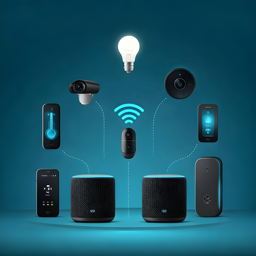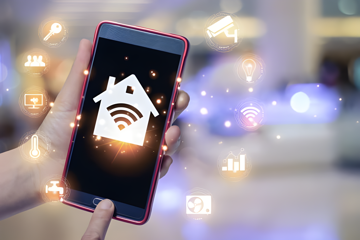Scalable ESP32 Hybrid LoRa-Wi-Fi Network for Agriculture
Optimizing BLE Power Consumption on ESP32 for IoT Efficiency
Bluetooth Low Energy Native Protocols: Wi-Fi (2.4 GHz), Bluetooth Classic, and BLEExplore ESP32 connectivity with Wi-Fi, Bluetooth Classic, and BLE. Learn implementation tips and best practices for IoT projects. (BLE) is a cornerstone technology for battery-powered IoT devices, offering a balance between connectivity and energy efficiency. However, optimizing BLE power consumption on the ESP32 is critical to extending battery life, especially in applications where devices must operate for months or even years on a single charge. This article dives into practical strategies to reduce BLE power consumption on the ESP32, ensuring your projects remain energy-efficient without compromising functionality.
Native Protocols: Wi-Fi (2.4 GHz), Bluetooth Classic, and BLEExplore ESP32 connectivity with Wi-Fi, Bluetooth Classic, and BLE. Learn implementation tips and best practices for IoT projects. (BLE) is a cornerstone technology for battery-powered IoT devices, offering a balance between connectivity and energy efficiency. However, optimizing BLE power consumption on the ESP32 is critical to extending battery life, especially in applications where devices must operate for months or even years on a single charge. This article dives into practical strategies to reduce BLE power consumption on the ESP32, ensuring your projects remain energy-efficient without compromising functionality.
Table of Contents🔗
1. Understanding BLE Native Protocols: Wi-Fi (2.4 GHz), Bluetooth Classic, and BLEExplore ESP32 connectivity with Wi-Fi, Bluetooth Classic, and BLE. Learn implementation tips and best practices for IoT projects. Power Dynamics
Native Protocols: Wi-Fi (2.4 GHz), Bluetooth Classic, and BLEExplore ESP32 connectivity with Wi-Fi, Bluetooth Classic, and BLE. Learn implementation tips and best practices for IoT projects. Power Dynamics
2. Adjusting Connection Intervals
3. Optimizing Advertising Parameters
4. Leveraging ESP32 Sleep Modes LTE Power Saving: Combining PSM and DRX with ESP32 Sleep ModesDiscover how combining LTE power-saving modes with ESP32 sleep techniques can extend battery life in IoT devices while ensuring reliable connectivity.
LTE Power Saving: Combining PSM and DRX with ESP32 Sleep ModesDiscover how combining LTE power-saving modes with ESP32 sleep techniques can extend battery life in IoT devices while ensuring reliable connectivity.
5. Reducing TX Power Adaptive Data Rate (ADR) Optimization for LoRaWAN on ESP32Optimize your IoT network with our ADR tutorial for ESP32 in LoRaWAN. Learn dynamic transmission tuning, power management, and troubleshooting strategies.
Adaptive Data Rate (ADR) Optimization for LoRaWAN on ESP32Optimize your IoT network with our ADR tutorial for ESP32 in LoRaWAN. Learn dynamic transmission tuning, power management, and troubleshooting strategies.
6. Using Notifications Instead of Polling
7. Firmware-Level Optimizations
8. Practical Example: BLE Native Protocols: Wi-Fi (2.4 GHz), Bluetooth Classic, and BLEExplore ESP32 connectivity with Wi-Fi, Bluetooth Classic, and BLE. Learn implementation tips and best practices for IoT projects. Sensor Node
Native Protocols: Wi-Fi (2.4 GHz), Bluetooth Classic, and BLEExplore ESP32 connectivity with Wi-Fi, Bluetooth Classic, and BLE. Learn implementation tips and best practices for IoT projects. Sensor Node
9. Measuring Power Consumption Quick Comparison: Range, power consumption, costs, and complexity of each technologyDiscover the ideal wireless solution for your ESP32 IoT project by analyzing range, power, cost, and complexity. Optimize connectivity now.
Quick Comparison: Range, power consumption, costs, and complexity of each technologyDiscover the ideal wireless solution for your ESP32 IoT project by analyzing range, power, cost, and complexity. Optimize connectivity now.
10. Best Practices Zigbee Green Power: Ultra-Low-Power Energy Harvesting SolutionsDiscover how ZGP enables battery-free IoT devices through energy harvesting with ESP32 integrations, supporting smart home and industrial applications. and Real-World Considerations
Zigbee Green Power: Ultra-Low-Power Energy Harvesting SolutionsDiscover how ZGP enables battery-free IoT devices through energy harvesting with ESP32 integrations, supporting smart home and industrial applications. and Real-World Considerations
Understanding BLE Power Dynamics🔗
- Connection Interval: Time between data exchanges (shorter = faster response, higher power).
- Advertising Interval: Frequency of broadcast signals.
- TX Power
 Adaptive Data Rate (ADR) Optimization for LoRaWAN on ESP32Optimize your IoT network with our ADR tutorial for ESP32 in LoRaWAN. Learn dynamic transmission tuning, power management, and troubleshooting strategies.: Output strength (higher = longer range
Adaptive Data Rate (ADR) Optimization for LoRaWAN on ESP32Optimize your IoT network with our ADR tutorial for ESP32 in LoRaWAN. Learn dynamic transmission tuning, power management, and troubleshooting strategies.: Output strength (higher = longer range Quick Comparison: Range, power consumption, costs, and complexity of each technologyDiscover the ideal wireless solution for your ESP32 IoT project by analyzing range, power, cost, and complexity. Optimize connectivity now., more power).
Quick Comparison: Range, power consumption, costs, and complexity of each technologyDiscover the ideal wireless solution for your ESP32 IoT project by analyzing range, power, cost, and complexity. Optimize connectivity now., more power). - Duty Cycle: Time spent active vs. asleep.
- Example: A device advertising every 100ms consumes ~10x more power than one advertising every 1s.
Adjusting Connection Intervals🔗
Lengthening connection intervals reduces wake-ups. For ESP32 Setting Up ESP32 as a Wi-Fi Access PointMaster ESP32 AP configuration with our step-by-step guide. Set up a secure, local IoT network using practical code examples and optimization tips., set this in the connection parameters:
Setting Up ESP32 as a Wi-Fi Access PointMaster ESP32 AP configuration with our step-by-step guide. Set up a secure, local IoT network using practical code examples and optimization tips., set this in the connection parameters:
#include <BLEDevice.h>
void setup() {
BLEDevice::init("ESP32");
BLEServer *server = BLEDevice::createServer();
BLEService *service = server->createService("1234");
// Set connection interval: 45ms min, 400ms max (units: 1.25ms)
BLEConnectionParameters params;
params.setInterval(36, 320); // 36*1.25=45ms, 320*1.25=400ms
server->updateConnParams(server->getAddress(), params);
}
Optimizing Advertising Parameters🔗
Reduce advertising frequency and timeout:
BLEAdvertising *advertising = BLEDevice::getAdvertising();
advertising->setMinInterval(512); // 512*0.625ms = 320ms
advertising->setMaxInterval(1024); // 1024*0.625ms = 640ms
advertising->setMinPreferred(0); // No preference for connection
advertising->start();
| Parameter | Typical Value | Power Impact |
|---|---|---|
| Advertising Interval | 320ms-640ms | Low |
| Advertising Timeout | 30s | Medium |
Leveraging ESP32 Sleep Modes🔗
Combine BLE with ESP32’s Combining Wi-Fi with Deep Sleep for Low-Power ApplicationsLearn how to integrate Wi-Fi and deep sleep on ESP32 to maximize battery life in IoT devices. This guide offers practical tips and step-by-step instructions. sleep modes:
Combining Wi-Fi with Deep Sleep for Low-Power ApplicationsLearn how to integrate Wi-Fi and deep sleep on ESP32 to maximize battery life in IoT devices. This guide offers practical tips and step-by-step instructions. sleep modes:
void deepSleepBetweenEvents() {
esp_ble_conn_update_params_t params;
params.latency = 0; // No latency
params.min_int = 36; // 45ms
params.max_int = 320; // 400ms
esp_ble_gap_update_conn_params(¶ms);
esp_deep_sleep_start(); // Sleep until next BLE event
}
Trade-off: Deep sleep LTE Power Saving: Combining PSM and DRX with ESP32 Sleep ModesDiscover how combining LTE power-saving modes with ESP32 sleep techniques can extend battery life in IoT devices while ensuring reliable connectivity. disables Wi-Fi and peripherals. Use
LTE Power Saving: Combining PSM and DRX with ESP32 Sleep ModesDiscover how combining LTE power-saving modes with ESP32 sleep techniques can extend battery life in IoT devices while ensuring reliable connectivity. disables Wi-Fi and peripherals. Use esp_sleep_enable_ble_wakeup() for BLE Native Protocols: Wi-Fi (2.4 GHz), Bluetooth Classic, and BLEExplore ESP32 connectivity with Wi-Fi, Bluetooth Classic, and BLE. Learn implementation tips and best practices for IoT projects.-triggered wake-up.
Native Protocols: Wi-Fi (2.4 GHz), Bluetooth Classic, and BLEExplore ESP32 connectivity with Wi-Fi, Bluetooth Classic, and BLE. Learn implementation tips and best practices for IoT projects.-triggered wake-up.
Reducing TX Power🔗
Lower TX power Adaptive Data Rate (ADR) Optimization for LoRaWAN on ESP32Optimize your IoT network with our ADR tutorial for ESP32 in LoRaWAN. Learn dynamic transmission tuning, power management, and troubleshooting strategies. when range isn’t critical:
Adaptive Data Rate (ADR) Optimization for LoRaWAN on ESP32Optimize your IoT network with our ADR tutorial for ESP32 in LoRaWAN. Learn dynamic transmission tuning, power management, and troubleshooting strategies. when range isn’t critical:
esp_ble_tx_power_set(ESP_BLE_PWR_TYPE_DEFAULT, ESP_PWR_LVL_N12); // -12dBm
| TX Power | Range | Current Draw |
|---|---|---|
| 0dBm | 100m | 130mA |
| -12dBm | 10m | 45mA |
Using Notifications Instead of Polling🔗
Notifications push data only when changes occur, avoiding constant polling:
BLECharacteristic *tempChar = service->createCharacteristic(
"TEMP",
BLECharacteristic::PROPERTY_READ |
BLECharacteristic::PROPERTY_NOTIFY
);
void loop() {
float temp = readTemperature();
if (temp != lastTemp) {
tempChar->setValue(temp);
tempChar->notify();
lastTemp = temp;
}
delay(1000); // Check every 1s
}
Firmware-Level Optimizations🔗
- Disable redundant features: Turn off unused BLE
 Native Protocols: Wi-Fi (2.4 GHz), Bluetooth Classic, and BLEExplore ESP32 connectivity with Wi-Fi, Bluetooth Classic, and BLE. Learn implementation tips and best practices for IoT projects. roles (e.g., central mode if acting as peripheral).
Native Protocols: Wi-Fi (2.4 GHz), Bluetooth Classic, and BLEExplore ESP32 connectivity with Wi-Fi, Bluetooth Classic, and BLE. Learn implementation tips and best practices for IoT projects. roles (e.g., central mode if acting as peripheral). - Minimize broadcast data: Shrink advertisement packets.
- Batch sensor readings: Transmit multiple data points in one packet.
- Disable Serial Debugging
 Connecting ESP32 to Cloud Services via Wi-FiDiscover how to connect your ESP32 to AWS, Azure, and Google Cloud using secure Wi-Fi. This guide covers setup, error handling, and low power strategies.: UART
Connecting ESP32 to Cloud Services via Wi-FiDiscover how to connect your ESP32 to AWS, Azure, and Google Cloud using secure Wi-Fi. This guide covers setup, error handling, and low power strategies.: UART Interfacing ESP32 with Zigbee3.0 Devices (Xiaomi, Philips Hue)Unlock seamless smart home integration by following our detailed guide on bridging ESP32 with external Zigbee modules for reliable IoT solutions. consumes ~40mA.
Interfacing ESP32 with Zigbee3.0 Devices (Xiaomi, Philips Hue)Unlock seamless smart home integration by following our detailed guide on bridging ESP32 with external Zigbee modules for reliable IoT solutions. consumes ~40mA.
Practical Example: BLE Sensor Node🔗
A temperature sensor transmitting every 5 minutes:
| Parameter | Configuration | Current Draw |
|---|---|---|
| Advertising | Non-connectable, 2s interval | 8µA (sleep) |
| Active Time | 3ms per transmission | 15mA |
| Daily Consumption | 0.72mAh/day | ~5 years on 1500mAh battery |
Full Code Example:
#include <BLEDevice.h>
#include <BLEServer.h>
#include <BLEUtils.h>
#include <esp_sleep.h>
BLEServer *pServer;
BLEService *pService;
BLECharacteristic *pCharacteristic;
void setup() {
BLEDevice::init("ESP32_BLE_Sensor");
pServer = BLEDevice::createServer();
pService = pServer->createService("1234");
pCharacteristic = pService->createCharacteristic(
"4567",
BLECharacteristic::PROPERTY_READ | BLECharacteristic::PROPERTY_NOTIFY
);
// Set connection parameters
BLEConnectionParameters params;
params.setInterval(200, 400); // Min: 200ms, Max: 400ms
params.setLatency(4); // Skip up to 4 connection events
params.setTimeout(1000); // 1000ms supervision timeout
pService->start();
pServer->getAdvertising()->setMinInterval(500);
pServer->getAdvertising()->setMaxInterval(500);
pServer->getAdvertising()->start();
// Simulate temperature reading
uint16_t temperature = 2500; // 25.00°C
uint8_t compressedData[2];
compressedData[0] = temperature >> 8; // High byte
compressedData[1] = temperature & 0xFF; // Low byte
pCharacteristic->setValue(compressedData, 2);
pCharacteristic->notify();
// Enter light sleep
esp_sleep_enable_timer_wakeup(10 * 1000000); // 10 seconds
esp_light_sleep_start();
}
void loop() {
// Keep the loop empty for low-power operation
}
Measuring Power Consumption🔗
Tools:
- Joulescope or Nordic Power Profiler Kit for granular measurements.
- Multimeter in series with battery.
Code Snippet for Profiling:
void logPowerState() {
Serial.printf("CPU Freq: %d MHz\n", ESP.getCpuFreqMHz());
Serial.printf("BLE TX Power: %d dBm\n", esp_ble_tx_power_get(ESP_BLE_PWR_TYPE_DEFAULT));
}
Best Practices and Real-World Considerations🔗
When optimizing BLE power consumption Quick Comparison: Range, power consumption, costs, and complexity of each technologyDiscover the ideal wireless solution for your ESP32 IoT project by analyzing range, power, cost, and complexity. Optimize connectivity now. on your ESP32 devices, keep these best practices in mind:
Quick Comparison: Range, power consumption, costs, and complexity of each technologyDiscover the ideal wireless solution for your ESP32 IoT project by analyzing range, power, cost, and complexity. Optimize connectivity now. on your ESP32 devices, keep these best practices in mind:
- Test Under Real Conditions:
Laboratory conditions are great for initial tests, but field testing can reveal nuances like interference, variable battery performance, and user behavior that impact power consumption Quick Comparison: Range, power consumption, costs, and complexity of each technologyDiscover the ideal wireless solution for your ESP32 IoT project by analyzing range, power, cost, and complexity. Optimize connectivity now..
Quick Comparison: Range, power consumption, costs, and complexity of each technologyDiscover the ideal wireless solution for your ESP32 IoT project by analyzing range, power, cost, and complexity. Optimize connectivity now..
- Iterate and Monitor:
Use onboard power monitoring if possible, or external tools, to measure the actual consumption after each adjustment. Fine-tuning is an iterative process.
- Balance Trade-offs:
Always weigh the trade-off between power saving and the quality of service. For example, too long a connection interval might result in unresponsive devices, while too short intervals can drain a battery rapidly.
- Stay Updated:
The ESP32 Setting Up ESP32 as a Wi-Fi Access PointMaster ESP32 AP configuration with our step-by-step guide. Set up a secure, local IoT network using practical code examples and optimization tips. firmware and BLE libraries frequently receive updates that might include more efficient power saving techniques. Stay engaged with community forums and update your firmware accordingly.
Setting Up ESP32 as a Wi-Fi Access PointMaster ESP32 AP configuration with our step-by-step guide. Set up a secure, local IoT network using practical code examples and optimization tips. firmware and BLE libraries frequently receive updates that might include more efficient power saving techniques. Stay engaged with community forums and update your firmware accordingly.
By carefully tuning BLE parameters, leveraging sleep modes, and minimizing data overhead, you can significantly extend the battery life of your ESP32-based BLE devices. These strategies are essential for creating efficient, long-lasting IoT solutions Connecting ESP32 to Cloud Services via Wi-FiDiscover how to connect your ESP32 to AWS, Azure, and Google Cloud using secure Wi-Fi. This guide covers setup, error handling, and low power strategies..
Connecting ESP32 to Cloud Services via Wi-FiDiscover how to connect your ESP32 to AWS, Azure, and Google Cloud using secure Wi-Fi. This guide covers setup, error handling, and low power strategies..
Author: Marcelo V. Souza - Engenheiro de Sistemas e Entusiasta em IoT e Desenvolvimento de Software, com foco em inovação tecnológica.
References🔗
- ESP-IDF Programming Guide: docs.espressif.com/projects/esp-idf
- ESP32 Arduino Core Documentation: docs.espressif.com/projects/arduino-esp32
- ESP32 Arduino Core Repository: github.com/espressif/arduino-esp32
- Espressif Documentation: docs.espressif.com
- Espressif Repositories and Projects: github.com/espressif
 8 months ago
8 months ago